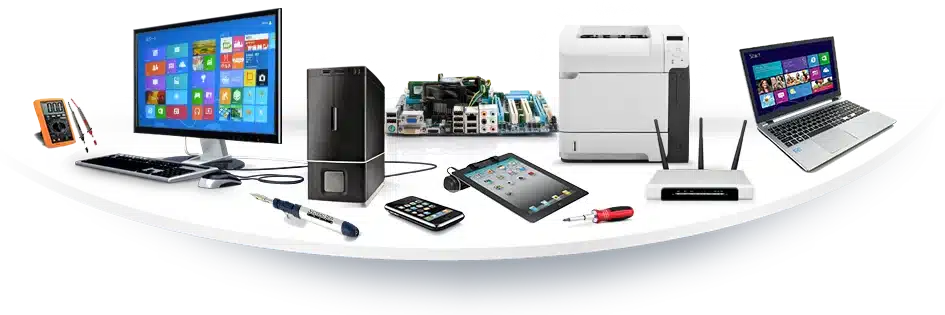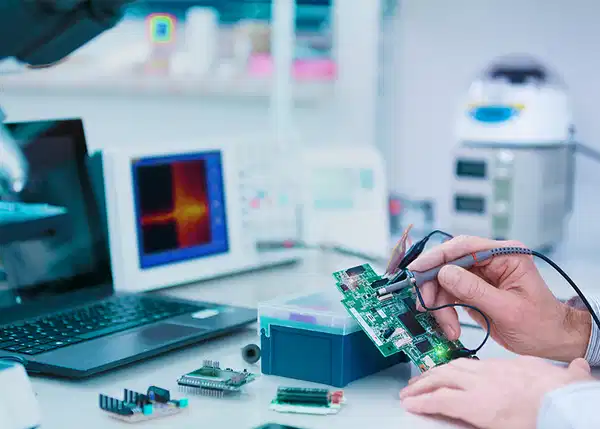Table of Contents
Have you ever noticed your smartphone getting hot after extended use or your laptop’s fan running loudly when multitasking? How to maintain electronic devices in high temperatures is crucial to ensure their longevity and performance. Excessive heat can cause slowdowns, malfunctions, or even permanent damage. Fortunately, with a few simple precautions, you can keep your devices cool and running efficiently, even in the summer heat. Let’s explore the best ways to protect your electronics from overheating.
The Damaging Effects of High Temperatures on Electronic Devices
Electronic devices are designed to operate within specific temperature ranges. When exposed to excessive heat, their performance and longevity are compromised. How to maintain electronic devices from heat is not just about preventing immediate damage; it’s about ensuring their long-term reliability. Below, we’ll examine the specific ways heat impacts your devices and the consequences of ignoring these risks.
Why Do Electronic Devices Overheat?
Before discussing how to keep your electronic devices from overheating, it is essential to first understand the reasons behind excessive heat buildup. Overheating is a common issue that can affect device performance and, if left unaddressed, may even lead to permanent damage. Whether you are using a smartphone, laptop, or any other electronic device, knowing what causes overheating can help you take the necessary precautions to prevent it. Here are the main factors that contribute to electronic devices heating up:
1. Internal Heat Generation
Electronic devices naturally generate heat during operation due to electrical resistance in their components. This heat buildup occurs as electrical energy is converted into thermal energy. For example, in integrated circuits, Joule heating is a primary mechanism responsible for internal heat production.
2. Compact Design and Small Size
Modern electronic devices, such as smartphones and laptops, are designed to be compact and lightweight. However, this miniaturization reduces the space available for effective heat dissipation. As components are packed closely together, thermal energy accumulates more quickly, making it harder for heat to escape efficiently.
3. Insufficient Ventilation
Proper ventilation is crucial for cooling electronic devices. When airflow is obstructed due to dust accumulation or when a device is placed in a confined space, heat cannot dissipate efficiently. Poor ventilation leads to increased internal temperatures, which can affect performance and longevity.
4. Heavy Usage and Resource-Intensive Applications
Running demanding applications, such as high-performance games, video editing software, or multitasking for extended periods, puts a significant load on the processor and other components. This increased workload generates excessive heat, pushing the device to its thermal limits.
5. High Ambient Temperatures and Environmental Factors
Using electronic devices in hot environments or under direct sunlight exacerbates overheating. When external temperatures are high, the device’s cooling system struggles to dissipate heat effectively, causing a rapid rise in internal temperatures.
6. Design and Manufacturing Issues
Poor hardware design or low-quality manufacturing materials can contribute to overheating. If a device lacks adequate heat dissipation mechanisms or is constructed with materials that trap heat instead of dispersing it, the risk of overheating increases significantly.
7. Faulty Connections and Wiring Issues
Defective electrical connections or damaged wiring can create resistance points within a device, leading to localized heating. This issue can result in irregular heat buildup, increasing the likelihood of malfunctions or permanent damage.
8. Inadequate Cooling Systems
Many electronic devices rely on cooling solutions like fans, heat sinks, or liquid cooling systems. If these cooling mechanisms fail, are poorly designed, or become clogged with dust, the device will struggle to regulate its temperature, leading to excessive heat buildup.
9. Internal Chemical Reactions in Batteries
In battery-powered devices, internal chemical reactions can contribute to heat generation. Faulty, old, or low-quality batteries may experience thermal runaway, where excessive heat leads to further reactions, causing the battery to overheat or even pose a fire hazard.
10. Excessive Voltage or Electrical Overload
Using power sources that supply higher voltage or current than recommended can lead to increased power dissipation and heat generation in electronic circuits. Overloading components beyond their designed limits can cause overheating, shortening the lifespan of the device.

Common Mistakes to Avoid
Many users unknowingly make errors that contribute to overheating, reducing device efficiency and lifespan. Understanding and avoiding these mistakes is essential for keeping your electronics cool and functioning optimally. Here are some common overheating mistakes and how to prevent them:
- Placing Devices on Soft Surfaces
Using a laptop on a bed, couch, or even a pillow might seem convenient, but it can block the ventilation system, preventing proper airflow. When airflow is restricted, the heat generated by the processor and other components gets trapped, leading to excessive heating. To avoid this, always place your laptop on a hard, flat surface like a desk or a cooling pad designed to enhance ventilation.
- Ignoring Overheating Warnings
Many devices provide built-in warnings, such as sudden slowdowns, automatic shutdowns, or high fan noise, to signal excessive heat buildup. Ignoring these signs and continuing to use the device under such conditions can lead to long-term damage. If your device overheats, shut it down immediately, allow it to cool, and check for possible causes, such as blocked vents or high processing loads.
- Using Harsh Cleaning Products
Cleaning your device regularly is important, but using the wrong products can do more harm than good. Abrasive materials, alcohol-based cleaners, and rough cloths can damage screens and vents. Instead, use a microfiber cloth with a mild, device-safe cleaning solution to maintain your electronics without harming their surfaces or ventilation.
- Overcharging Devices
Leaving devices plugged in overnight or after they are fully charged can generate unnecessary heat and degrade the battery over time. Lithium-ion batteries, commonly used in smartphones and laptops, are particularly sensitive to overcharging. To prevent heat-related damage, unplug your device once it reaches 100% or use smart plugs that automatically cut off power after charging.
- Running Heavy Applications Continuously
Using high-performance applications such as gaming, video editing, or 3D rendering software for long periods without breaks places a heavy load on the processor and graphics card. This continuous strain generates significant heat and can lead to thermal throttling, where the device slows down to protect itself. To avoid this, take regular breaks and close unnecessary applications when they’re not in use.
How to Protect Electronic Devices from High Temperatures
Protecting your devices from high temperatures doesn’t have to be complicated or costly. How to maintain electronic devices from heat involves adopting practical habits and using readily available tools. Below, we’ll outline the most effective strategies to keep your devices cool and functional.
1. Ensure Proper Ventilation
- Provide ample space around devices to allow for adequate airflow.
- Avoid placing devices in enclosed spaces or stacking them on top of each other.
- Use cooling pads or stands for laptops to enhance airflow underneath.
- Regularly clean ventilation ports and fans to prevent dust buildup.
2. Avoid Direct Sunlight
- Position devices away from windows or areas exposed to direct sunlight.
- Use curtains or blinds to reduce heat exposure in your workspace.
- Never leave devices in a hot car, as temperatures can soar to dangerous levels.
3. Utilize Cooling Accessories
- Invest in cooling pads with built-in fans for laptops.
- Use heat sinks or thermal pads for smaller devices like smartphones and tablets.
- Install additional fans or cooling systems for stationary devices like gaming consoles or desktop computers.
4. Optimize Device Usage
- Turn off devices when not in use to prevent unnecessary heat generation.
- Avoid running resource-intensive applications for extended periods.
- Adjust power settings to reduce energy consumption and heat output.
5. Maintain Regular Cleaning
- Use compressed air to remove dust from vents, fans, and internal components.
- Clean screens and exteriors with a microfiber cloth and appropriate cleaning solutions.
- Schedule routine maintenance to ensure optimal performance.
6. Prevent Overcharging
- Disconnect chargers once the device reaches full charge to avoid overheating the battery.
- Use smart chargers that automatically stop charging when the battery is full.
7. Monitor Device Temperature
- Install apps or software to track your device’s temperature in real-time.
- Use external temperature sensors for devices that lack built-in monitoring features.

Simple Steps to Repair Heat-Damaged Devices
If your device has already suffered heat damage, don’t panic. How to maintain electronic devices that have been affected by overheating involves taking immediate action to mitigate further damage.
- Power Off the Device
- Turn off the device and disconnect it from any power source.
- Turn off the device and disconnect it from any power source.
- Allow the Device to Cool
- Place the device in a cool, well-ventilated area for several hours.
- Avoid rapid cooling methods like refrigerators, which can cause condensation.
- Inspect the Battery
- Remove the battery (if possible) and check for swelling, leaks, or other damage.
- Remove the battery (if possible) and check for swelling, leaks, or other damage.
- Clean Internal Components
- Use compressed air to clean dust from vents, fans, and internal parts.
- Use compressed air to clean dust from vents, fans, and internal parts.
- Test the Device
- After cooling, power on the device and monitor its performance.
- After cooling, power on the device and monitor its performance.
- Replace Damaged Parts
- If necessary, replace faulty components like fans or thermal paste.
- If necessary, replace faulty components like fans or thermal paste.
- Implement Preventive Measures
- Follow the tips outlined above to prevent future overheating issues.
How to maintain electronic devices from high temperatures is an essential skill for anyone who relies on technology. By understanding the risks of overheating and adopting preventive measures, you can protect your devices and extend their lifespan. Remember, proactive care is always more effective than reactive repairs.
Start implementing these strategies today to keep your devices running smoothly, even in the hottest conditions. For the best selection of high-quality electronic devices, visit Soum and find the perfect addition to your tech collection.
















